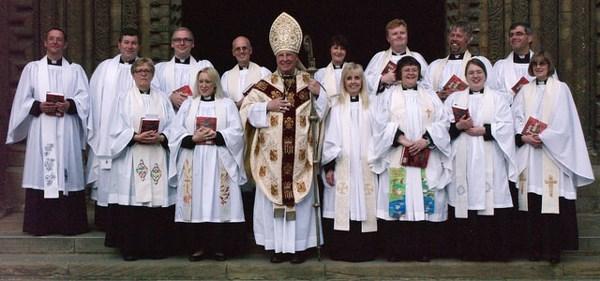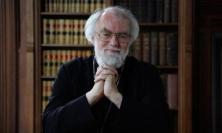The legislation passed last month to allow the consecration of women bishops in the Church of England, and the lengthy discussions which preceded this, brought to the fore many questions about decision-making in the established Church. Thinking Faith asked Rev Dr Emma Percy to give an account of the structures of authority within the Church of England and explain how she sees the workings of the Spirit therein.
On 14 July 2014, the General Synod of the Church of England passed legislation to allow a woman, suitably qualified, to be consecrated as a bishop. It brings to an end decades of debate during which the orders of deacon, priest and bishop have been gradually opened to women. This article explores the nature of decision-making in the Church of England around this issue and how this reflects the ambiguous nature of authority within our Church. I write as one of the women who was selected as a deaconess, ordained as a deacon and then waited four years for ordination as a priest. I have campaigned for the opening of all orders to women, so my position is inevitably partial.
Trying to square a circle
The Church of England is a complex mix of catholic and protestant ecclesiology. We are episcopally led, synodically governed and ‘by-law-established’. Thus, there is a mixture of democracy and hierarchy, of lay and clergy leadership. For most Anglicans in England, it is assumed that the Holy Spirit works in and through the processes that have evolved over time. A recent report on the structures for shaping episcopal appointments (2001) had no trouble titling itself Working with the Spirit: Choosing Diocesan Bishops. The Church of England generally assumes that its structures – even quite recent ones – are ‘ordained’. Thus pragmatic and expedient decisions will be narrated as the leading of the Spirit. As such, many Anglicans gradually come to believe that the changes we make to our structures are, in some respects, also God’s direction for the Church.
However, some Anglicans believe that the Church of England does not have authority to make changes that have not been made by the Roman Catholic or Orthodox Churches that make up the majority of Christians in the world. We do not, for example, have the authority to ordain or consecrate women; authority for such changes lies beyond our Church. Others still believe that all decisions must be measured against a particular way of reading scripture; while the majority may interpret the bible in ways that can accommodate women in authority, this group cannot understand the texts in this way. For them, all authority is subject to the test of their scriptural reading. This includes the authority of a bishop or of synod.
The tradition of the Church of England is to look, where possible, for consensus, and to try to maintain a broad Church where differences are tolerated. In the debates over the admission of women to Holy orders, this has often meant trying to square a circle: can a Church which claims the authority to ordain women, respect and honour those who do not believe that these ordinations are valid? Thus, the debates over these last decades have not simply been about the theology of women’s ordination, but about how to hold together contradictory ideas about authority. In moving to open all orders to women, legislation has been prepared which has needed to be approved by the House of Bishops, the General Synod and the Ecclesiastical Committee of Parliament. It is a process full of revision and scrutiny that inevitably leads to compromises. Frequently, this means that those looking from the outside accuse the Church of fudging issues and sitting on the fence.
The legacy of 1992: Two integrities
In preparing legislation to allow women to be consecrated as bishops, the Church had to deal with the legacy of decisions made when women were admitted to the priesthood. The 1992 legislation that allowed women to be ordained to the priesthood made provisions for clergy and parishes that could not in conscience accept the ministry of a woman priest. They could pass resolutions to prevent either a woman presiding at the Eucharist in their parish (Resolution A) or becoming an Incumbent (Resolution B). These resolutions reflected the different concerns of those opposed to the ordination of women: some questioned a woman’s sacramental integrity as a priest, whilst others were concerned about women in leadership roles.
This legislation, like all major changes, had gone through drafts and revisions. It had been passed by the dioceses and came to Synod in November 1992, where it needed a two thirds majority in each of the houses: Bishops, Clergy and Laity. It received the necessary majority with an extremely tight vote in the House of Laity. There was much jubilation from those in support, alongside concern for those who were opposed. It was suggested that Parliament, which contained a number of prominent MP’s opposed to the change, might not ratify the legislation if better provision was not provided for opponents. So the House of Bishops decided to act and strengthen the provision for those opposed. They produced a paper called The Bonds of Peace, which became the Episcopal Ministry Act of Synod, 1993. It was passed by Synod in an attempt to hold the Church together. This was a piece of legislation which had not gone through all of the revisions, amendments and diocesan scrutiny of the main legislation.
This Act of Synod specifically allowed parishes and clergy to request the ministry of a bishop who had not participated in any ordinations of women; this became Resolution C. It allowed for the creation of three Provincial Episcopal Visiting Bishops, soon to be known as the ‘Flying Bishops’, to care for those opposed to the admission of women to the priesthood. Whilst the legislation had ensured that people could opt out of the ministry of a woman priest, this Act went further. It meant that parishes and clergy could choose their bishop on the grounds of his stance on one aspect of church practice. A diocesan male bishop, duly ordained and consecrated by the Church, could be declared, at some level, unsatisfactory because he had participated in the ordination of women. The Act also led to the principle of ‘two integrities’ within the Church and thus a resistance to the original idea of reception of women’s ministry. Those who opposed could live and work in a church within the Church, protected from the priestly ministry of women and the episcopal ministry of those who ordained them.
Understanding the effect of this Act helps to comprehend the difficulty of the discussions around the consecration of women bishops. The major provision in the Act of Synod was for the wing of the Church worried about sacramental assurance; those who had concerns about women’s authority over men were provided for in the original legislation. However, as the years have passed and parishes have encountered issues where they are in disagreement with their diocesan bishops, they have begun to call for their own episcopal provision. The Act of Synod had unwittingly opened the door to the suggestion that clergy and parishes should be able to call on a bishop of similar views to conduct episcopal ministry within their churches. Parishes could judge whether or not their bishop was in tune with their theology. And the idea that this bishop might be a woman raises theological issues for those concerned about sacramental assurance and those who object to the authority of women over men.
In the bulk of the Church, the reception of women priests has been overwhelmingly positive. Many who were troubled by the idea or actively campaigned against the change have found that the reality is fine. The wider population whose relationship to the established Church is more tenuous have, by and large, come to see women clergy as normal and thus have been bemused by the fact that bishops still had to be male. Numbers training for the ministry have moved close to 50:50 men and women, and thus it has become increasingly difficult to justify why talented women clergy should not be selected as bishops. For most of the Church, if women can be priests it makes no theological sense to say they cannot be bishops.
Yet, the policy of two integrities meant that those strongly opposed have been able to create areas of the Church which are women-free. If you do not accept that the Church had the authority to ordain women priests, then it definitely does not have the authority to consecrate them as bishops. If women should not be in positions of authority over men, then they certainly should not be bishops, a role which requires male clergy to take an oath of canonical obedience. Thus, the Church has faced a dilemma. How do you create safe places for those who are opposed to women’s ordination, or consecration, whilst ensuring that a woman bishop has the full authority of a bishop?
The road to the new legislation
The first attempt to pass legislation to allow for the consecration of women to the episcopate was drawn up by a steering committee that had been tasked with holding together these two integrities. It was a lengthy process of discussion and revision. Compromise was expected from all sides. When the measure eventually came for its initial approval by Synod, before being sent out for diocesan approval, the Archbishops intervened with an amendment to increase the provisions for those opposed. Synod defeated this amendment as unworkable. This was a difficult experience for many, as it meant defying the authority of the Archbishops. The measure was then passed by all but three of the dioceses and was due for final approval in Synod in July 2012. The House of Bishops, in an unusual intervention, amended the legislation (clause 5.1c). The House of Clergy in Synod defeated this amendment, as it would have placed in law the right of a parish to choose their bishop according to their ‘theological conviction’. No definition of the limits or discernment process of such theological conviction was given. The final vote on the legislation was moved to November.
In November, the legislation returned to Synod with a new amendment, which it was hoped would satisfy all parties. It did not, and the measure failed to get two thirds majority in the House of Laity. The consequent distress within and beyond the Church came as a shock to many, especially those who had been caught up in the minutiae of legislative amendments. Synod seemed out of step with the mind of the majority of the Church, and definitely out of step with the State. Questions were raised in Parliament about a State Church which continued to discriminate legally against women. Questions were raised in churches about the make up of synod. The incoming Archbishop of Canterbury knew that this could not simply be left to the standard legislative procedure, which would have meant that the matter was closed for the next five years.
A new way of looking at the issue was initiated by the Archbishop. There was a move away from a legislative solution in which all provisions would be enshrined in the law of the land. Facilitated conversations between those with opposing views were held, and a new simpler legislation was presented. Alongside the measure, all were asked to trust the House of Bishops and their declaration, which outlines the principles and conflict resolution procedures that will come into play when women are consecrated as bishops. Part of this declaration is the statement that the Church has reached a clear decision on opening up all orders to women. Yet, there is still a desire to find a way for those who cannot accept this decision to flourish within the Church. The measure was passed with substantial majorities in all three Houses in July 2014. It has now also been passed by the Ecclesiastical Committee of Parliament. Part of the narrative in the July Synod was that the Holy Spirit had stopped us making poor legislation in November and brought us to a better place.
A public struggle
At its best, this whole process has been described as a way of living well with disagreement and difference. At its worst it has been an attempt to hold together opposing views without seeking to discern where the truth lies. It has highlighted the diffuse and contested nature of authority within the Church. This has been an argument about the authority of bishops, coming from those who wish to be able to question that authority when it does not conform to their own understanding of the truth. It has been an argument about what authority the Church of England has to discern God’s leading for itself. It has been an argument about what role individual conscience plays for those who are representatives of a wider constituency. It has been an argument about the authority of scripture, and how it is interpreted. And, in the midst of all of that, it has been an argument about gender, about how far changes in society should be reflected in the Church and whether the mission of the Church is best served by allowing all those called into ministry to feel affirmed and valued. All of these arguments will rumble on and the Church of England will continue to do its theology in this pragmatic, diffuse – and, at times, incoherent – way.
Those of us who find our spiritual home in this Church can be frustrated at times by the lack of clarity. I am not alone in finding it hard to live and work in a Church whose House of Bishops has declared that those who do not think I am a priest must be enabled to flourish. However, I am committed to the breadth the Church represents and to an ecclesiology which allows for the uncovering of truth rather than its imposition. There is a sense in which all of our truths are partial and, even when I believe passionately that I am right, the process of debating, praying and campaigning for the truth as I see it becomes a means to hone my own understanding. I have had to deepen my knowledge of scripture and theology as I have wrestled with the ideas of others. This, though uncomfortable, has strengthened my voice and enabled me to speak well in other places of discrimination. The Church’s public struggle over issues of gender highlights continuing problems in gender relations, which are often unstated, in the wider world.
I am, though, concerned that we are, as a Church, less theologically literate than we were. We are not immune to the spirit of the age and are tempted by soundbites, strap lines and neat answers. Yet, in this decision, where I might like a neat answer, we have a compromised one. Women can be bishops but somehow we must honour the minorities who hold different views. Uncomfortable as it is, I know that this allows people to take their time in changing their opinions. Many gradually altered their once stridently-held opinions against women priests once they had begun to experience the reality. I expect it will also be the case, in time, over women bishops; many will simply become accustomed to this new reality and their thinking will catch up.
Anglicans are clear that the Church is a fallible human institution through which God works. In reading the bible stories we see time and again how God works in and through compromised individuals and communities. Often the direction can only be understood when looking back. So as we prepare to discuss more uncomfortable issues around sexuality I hope that we can draw on good theology and reasoned debate. I fear, though, that it will be messy and painful, and the outside world will find much of it unedifying. In it all, I and others will continue to pray that the Holy Spirit can guide us, despite our failings, so that by the grace of God we may stumble towards the truth and the gospel of the Kingdom may be lived and taught.
Rev Dr Emma Percy is Chaplain to Trinity College, Oxford.






